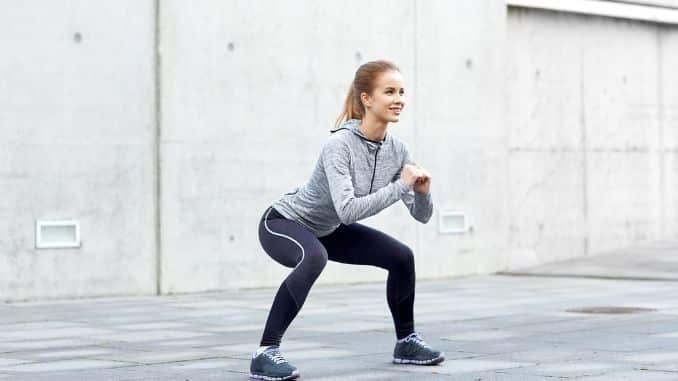Squats are a fantastic exercise for building strength, but for many, they come with an unwelcome side effect: neck pain when squatting. If you’ve ever felt discomfort or strain in your neck during squats, or if your neck hurts after performing them, you’re not alone. Fortunately, there are several strategies you can implement to alleviate this issue and ensure that your squatting routine remains effective and pain-free.
This problem often arises due to poor posture or incorrect alignment during the movement. The good news is that you can avoid neck pain and make squats more effective with a few adjustments.
Let’s dive into why squats hurt your neck and how you can fix it.
Common Causes Of Neck Pain During Squats

If you’re experiencing neck pain while squatting, it’s likely due to improper squat form and inadequate engagement of your back and neck muscles. How to Fix Neck Pain From Squats starts with proper positioning—ensuring your neck stays in a neutral alignment and your upper back is engaged to support the weight effectively.
As Dr. Mark Queralt notes, “Most cases of acute back or neck pain resolve in a matter of weeks regardless of treatment.” However, if your pain persists, a specialist can help you understand and address the underlying issues.
Here are some of the main culprits:
- Poor head alignment: Many people unknowingly push their heads forward or look down when squatting. This misalignment places excess strain on the neck muscles, causing pain.
- Forward head posture: Your head weighs around 12 pounds. Pushing it forward, especially at a steep angle, increases the load your cervical spine must support. A slight tilt of 15 degrees can make your neck support up to 27 pounds. If you go as far as 60 degrees, your neck is handling nearly 60 pounds!
- Rounded shoulders: Along with poor head alignment, rounded shoulders can reduce your body’s balance. This posture compromises your form and increases pressure on your neck during squats.
- Barbell placement: If you perform barbell squats, incorrect bar placement can exacerbate neck strain. A bar positioned too high on the back can directly press on the neck area, leading to discomfort. Beginners might consider using a barbell pad to alleviate the pressure of the barbell. However, improper bar placement can also cause a neck bruise, highlighting the importance of proper technique.
How To Correct Squat Form To Avoid Neck Pain
The good news? There are simple ways to fix your squat form and reduce neck pain [2].
1. Head And Neck Alignment
The first step is to ensure your head stays aligned with your spine throughout the movement. Here’s how:
- Keep your gaze forward and slightly down, not at the ceiling or floor. Retract your shoulder blades to create a stable base for the bar.
- Imagine keeping your ears aligned with your shoulders. This will help maintain neutral cervical spine alignment and prevent your head from tilting forward. Proper bar placement also helps prevent strain on the shoulder muscles.
Keeping your head in the correct position minimizes the risk of neck strain during squats.
2. Shoulder Blades And Upper Back Positioning
Avoid rounding your shoulders forward. Instead, pull them back and engage your upper back muscles. This keeps your upper body stable and strong, reducing the likelihood of neck pain.
3. Proper Barbell Placement For High Bar Squat
For those performing barbell squats, ensure the bar is placed on your upper trapezius muscles rather than your neck.
Using padding or adjusting the bar’s position slightly lower can help distribute the weight better and alleviate pressure on your neck.
Try The Pistol Squat To Reduce Neck Strain
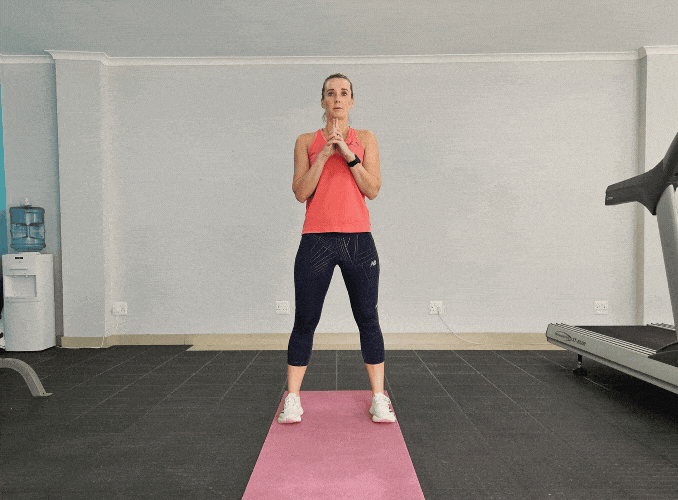
- Begin in an upright standing position with your feet wider than shoulder-width apart, hands at your chest, fingers interlaced or palms pressed together, maintaining good alignment with your head, shoulders, and hips.
- Engage your core and lower your body by bending both knees.
- Keep your chest lifted as you squat, ensuring your knees do not extend past your toes.
- Aim to go as low as possible while keeping your heels on the ground. Push through your heels to return to the starting position and repeat the movement.
- Start with 1 set of 10 repetitions.
Advanced Squat Variations to Reduce Neck Pain
In addition to the Pistol Squat, other squat variations can help reduce strain on the neck:
1. Goblet Squat
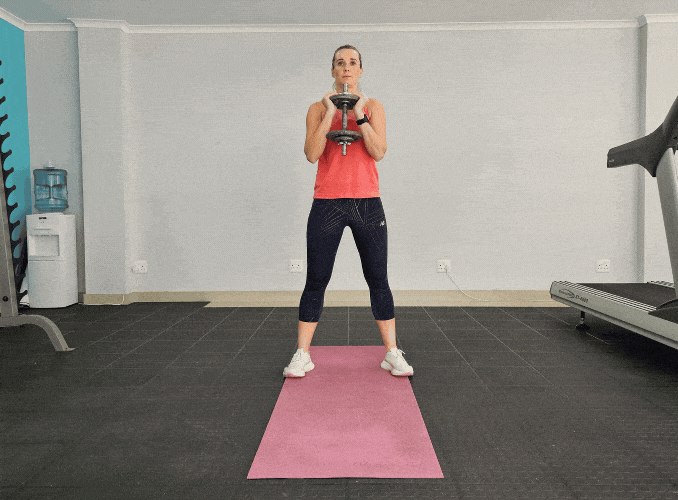
- Begin in an upright standing position with your feet wider than shoulder-width apart, maintaining good alignment with your head, shoulders, and hips.
- Clasp your hands together in front of you, with your palms facing each other and positioned close to your chin, elbows pointing downward.
- Engage your core and lower your body by bending your knees and pushing your hips back.
- Keep your chest lifted and your hands close to your body as you squat down, ensuring your knees do not extend past your toes.
- Aim to lower your body until your thighs are parallel to the ground.
- Press through your heels to return to the starting position and repeat the movement.
- Start with 1 set of 10 repetitions.
2. Sandbag Squat
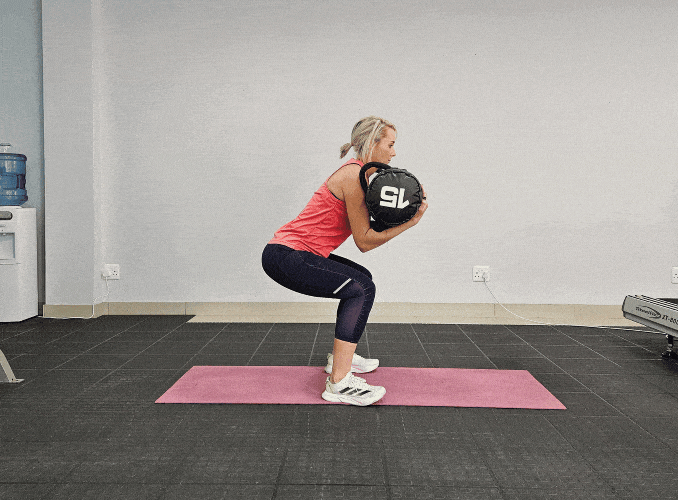
- Begin in an upright standing position with your feet shoulder-width apart, maintaining good alignment with your head, shoulders,hips and legs.
- Hold a sandbag close to your chest with both hands.
- Engage your core and lower your body by bending your knees and pushing your hips back.
- Keep your chest lifted and the sandbag secure as you squat down, allowing your elbows to rest on the inside of your knees.
- Ensure your knees do not extend past your toes as you aim to lower them until your thighs are parallel to the ground.
- Press through your heels to return to the starting position and repeat the movement.
- Start with 1 set of 10 repetitions.
3. Bulgarian Split Squat
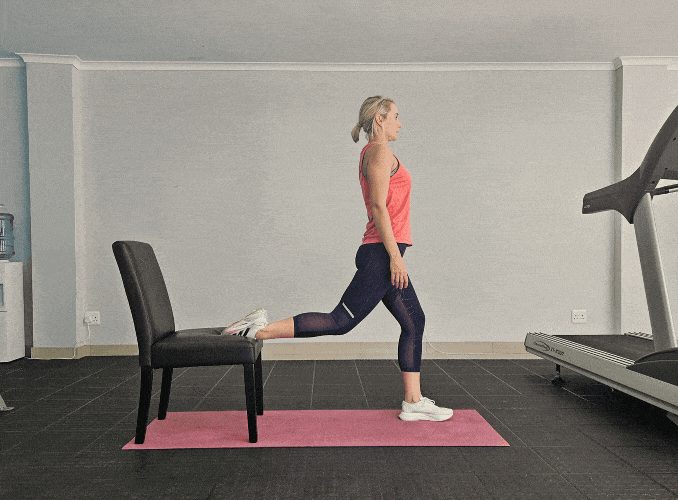
- Begin in an upright standing position in front of a chair or a bench with your feet shoulder-width apart, maintaining good alignment with your head, shoulders,hips and legs.
- Place one foot on the chair behind you, ensuring your toes are pointed down.
- Engage your core and lower your body by bending your front knee and lifting your chest and back straight.
- Aim to lower until your front thigh is parallel to the ground, ensuring your knee does not extend past your toes.
- Press through your front heel to return to the starting position.
- Start with 1 set of 10 repetitions per leg.
These variations offer effective ways to strengthen your lower body without putting too much stress on your neck.
Common Mistakes That Cause Neck Pain During Squats
To further avoid neck pain during squats, it’s essential to understand common mistakes contributing to the issue. Here’s what to watch out for:
- Looking up or down excessively: Your head should be neutral. Looking up at the ceiling or down at your feet can cause neck strain.
- Leaning too far forward: When your torso leans too far forward, it shifts the weight toward your neck and shoulders, increasing the risk of discomfort.
- Failing to engage your core: A weak core can lead to poor posture, which puts extra pressure on your neck and upper back. Engage your core to help distribute the weight more evenly.
You’ll have a more efficient and pain-free squat by avoiding these mistakes.
Understanding Body Mechanics: Why Neck Pain Happens
When your upper body positioning is off, the risk of neck strain increases. Body mechanics in squatting play a huge role in how well your muscles distribute the weight.
A misaligned neck and poor posture lead to neck tension that can make squats painful. Underdeveloped back muscles can contribute to poor form and neck pain.
Using too much weight during squats can lead to improper form and significant stress on various joints, particularly the knees and elbows. This increases the risk of pain and injury due to poor posture and muscle strain.
The Importance Of Spine And Neck Alignment
Your spine is designed to stay in a neutral position during most exercises. When experiencing neck pain when squatting, it’s often due to misalignment of your cervical spine (neck), which should stay in line with the rest of your body. Poor positioning forces your neck muscles to compensate, leading to discomfort. To prevent this, focus on maintaining a neutral gaze, avoid excessive forward or upward head movement, and ensure proper form to reduce strain on your neck muscles.
Dr. Seth A. Waldman, M.D., emphasizes the importance of proper neck alignment and warns against ignoring “red flags” like pain with weakness or loss of bowel or bladder function. Improper form can also risk serious injuries, including spinal cord damage and disc herniation. Dr. Waldman recommends NSAIDs and gentle stretching for mild neck pain and advises seeing a specialist if the pain persists.
The Role Of Breathing In Squat Mechanics
Believe it or not, breathing mechanics can also influence your squat posture. Improper breathing can cause you to lose core stability, leading to poor body mechanics and increased stress on the neck and shoulders—especially if you’re already experiencing neck pain when squatting. Try practicing diaphragmatic breathing during your squats to maintain stability and reduce strain:
- Take a deep breath into your belly before you descend.
- Brace your core.
- Exhale as you rise.
Anatomy Of The Neck And Back: Why Squats Can Hurt Your Neck
The neck and back are complex structures that provide vital support during exercises like squats. Understanding their anatomy can help you identify why you might experience neck pain when squatting and how to fix it. Proper form, maintaining a neutral spine, and ensuring your bar placement and muscle engagement are key to preventing discomfort and keeping your squats pain-free.
1. Neck Anatomy (Cervical Spine)

The neck consists of seven vertebrae (C1-C7), collectively known as the cervical spine, which supports the head and allows movement. Muscles like the trapezius and levator scapulae stabilize the neck during activities like squats.
However, when your head moves forward or out of alignment, it places extra strain on the cervical spine and these muscles, leading to discomfort.
- Cervical Discs: Cushion and absorb shock between vertebrae, but poor form can overload them.
- Neck Muscles: Overcompensate when the head moves out of alignment, leading to strain.
2. Back Anatomy (Thoracic And Lumbar Spine)

The back consists of the thoracic (T1-T12) [1] and the lumbar (L1-L5), which support the upper and lower body, respectively. These areas work together to stabilize your torso during squats.
- Thoracic Spine: Helps maintain upright posture. Rounding in this area pulls the head forward, increasing neck strain.
- Lumbar Spine: Bears much of the body’s weight. Weak or poorly positioned can cause the upper body, including the neck, to compensate.
- Erector Spinae and Trapezius Muscles: Key to maintaining proper alignment during squats. Weakness or improper activation can shift stress to the neck.
3. How Squats Affect The Neck And Back
During squats, keeping a neutral spine from head to pelvis is crucial. Misalignment in any part of the spine—whether through forward head posture or rounded shoulders—can transfer extra stress to the cervical spine.
Additionally, improper bar placement during barbell squats can directly strain the neck.
Preventing Squat-Related Neck Pain Long Term
To avoid neck injuries in the future, consider these long-term strategies:
- Warm-Up Properly: Before you squat, engage in dynamic stretches and mobility exercises targeting your neck, shoulders, and upper back. A thorough warm-up improves flexibility and reduces the risk of injury.
- Monitor Your Form: Regularly check your squat form. Record yourself or ask a coach to correct your head and neck alignment.
- Gradually Increase Weight: If you’re lifting heavy, start light and focus on the correct form before increasing the weight. This helps prevent neck pain caused by an imbalance in your body mechanics.
Final Thoughts
Experiencing neck pain when squatting can be frustrating, but you can eliminate the discomfort by correcting your form, improving your body mechanics, and strengthening your muscles. It starts with focusing on head alignment, using squat modifications like the Pistol Squat, and ensuring proper barbell placement to reduce strain.
With the right approach, you can squat safely without worrying about your neck hurting. Have any other tips or questions about squat-related neck pain? Let us know in the comments below!
If you are looking for a system designed to prevent and treat neck pain, click here to check out the Neck Pain Solved program.
FAQ
How Long Does A Strained Neck Take To Heal?
Neck pain from muscle strain typically heals in a few days. If it lasts longer, treatments like stretching, physical therapy, or massage can help.
How To Relieve Neck Pain From Squatting?
Use an ice pack for swelling or a heat pack to relax muscles. Gentle stretches and massages may also provide relief.
How To Protect Your Neck When Squatting?
Keep your head neutral and gaze forward, engaging your core to maintain proper posture and prevent strain on your neck.

